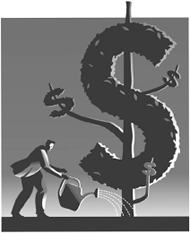By JENNY ANDERSON - New York Times
The hedge fund party seemed to be quieting down not so long ago. Returns were flagging. Blowout start-ups were fading from memory.
The hype and hyperbole are now back. Another star of finance is doing what all good stars do these days: start a really, really big hedge fund.
In September, Jon Wood, a former top trader with UBS, will start SRM Global Fund in Monaco, with commitments of more than $5 billion and capital of more than $3 billion to start with, according to people briefed on the fund. That puts him close to the record, set by Jack R. Meyer, the former investment manager of Harvard University’s assets, who raised more than $6 billion for Convexity Capital earlier this year.
It was not long ago that a $3 billion start-up had jaws dropping — and calculators clicking. Hedge fund managers tend to make a 2 percent management fee and take 20 to 25 percent of profits; 2 percent of $3 billion is $60 million. In November 2004, a former Goldman Sachs wunderkind, Eric Mindich, began Eton Park Capital Management with more than $3 billion. Last year, Dinaker Singh, who also hails from Goldman, started a $2.5 billion fund, which quickly soared to more than $5 billion.
Mega-start-ups, while less frequent, are arriving with a far bigger bang. Last year, 22 people started funds bigger than $1 billion, according to Chicago-based Hedge Fund Research. This year, only two hedge funds of $1 billion or more have been started: Mr. Meyer’s Convexity and Old Lane, run by Vikram Pandit and John Havens, former Morgan Stanley executives, who are said to have raised $2 billion to $4 billion. They did not return calls for comment.
While the stars seem to have no problems raking in billions, starting small is increasingly difficult, say people involved in fund-raising whose banks forbid them from speaking on the record.
“Raising $15 million to $50 million is much harder than it used to be,” said one fund-raiser.
Pedigree helps. Mr. Wood made roughly $500 million for UBS every year for at least half a dozen years, said one person who worked with him. Marketing materials indicate he never had a down month.
UBS, known for its conservatism, invested $500 million in his hedge fund. Management fees range from 1 to 1.5 percent, based on a three- to five-year lockup, and Mr. Wood and his team take 25 percent of the profits.
Some investors worry that traders like Mr. Wood, who come from a bank’s trading floor, will not be able to achieve the same high returns after leaving the mother ship. Banks are a treasure trove of people, ideas and capital flows, giving traders inside those organizations a clear edge.
But Mr. Wood has not worked on the physical main trading floors of UBS for years. He has operated from the Bahamas, Gstaad, Switzerland, and now Monaco. He told investors he did not need a large team because he has not operated with a large team for years.
Even losing a high-profile court case in London last year didn’t seem to dent Mr. Wood’s ability to attract billions. Mr. Wood and another minority shareholder in a retail chain brought a claim against Tom Hunter, a Scottish entrepreneur, over the acquisition of another retailer. The judge in the case called Mr. Wood an “evasive” witness who was a “very hard and calculating man.” UBS lost Sir Tom as a client of the private bank.
Mr. Wood will face many challenges, including investing $3 billion (and later $5 billion) successfully while running a business. His team includes four people. By comparison, Mr. Mindich began his fund with 50 people.
Obstacles aside, Mr. Wood is certain to be deluged by money coming from pension funds and endowments looking to get in hedge funds, and looking for a big name in particular. In the second quarter, investors gave hedge funds more than $42.1 billion, according to Hedge Fund Research, the highest level of inflows since the organization has been tracking flows, according to Joshua Rosenberg, president of Hedge Fund Research.
Returns, which soared in the first half of the year, have recently been rocky: down 1.54 percent in May and 0.15 percent in June. But for the year through July, the average fund is up 6.2 percent, compared with 2.7 percent for the Standard & Poor’s 500-stock index.
The case for hedge funds may get harder. Recently, noncorrelated asset classes have become correlated, like gold and stocks. Many hedge funds sank with the equity markets they invested in. Interest rates are headed north, which should make cash look more attractive since hedge fund performance has averaged 9 percent over the last two years.
And yet, the money keeps coming in, inundating the established managers. To investors, these are hedge fund heroes, sent from Monaco, to return them to the days of over-the-moon returns. If they are not enough, there will be more: Ralph Rosenberg, a former Goldman trader, is expected to start a fund, R6, this fall with at least $1 billion and two former Goldman traders are planning to begin Montrica in Britain.
Expected size? More than $1 billion. Not so jaw-dropping anymore.
Ex Dividend Stocks for April 2022
3 years ago



















No comments:
Post a Comment